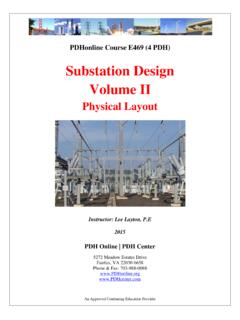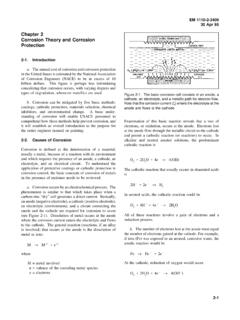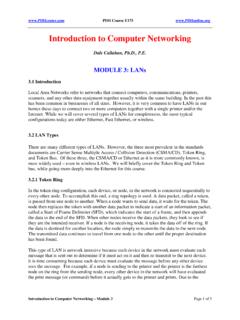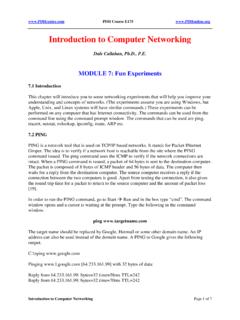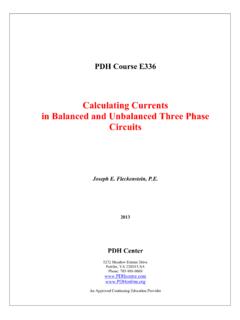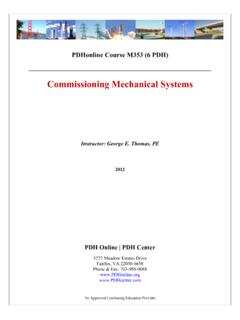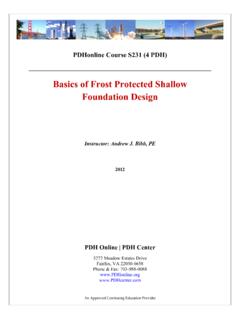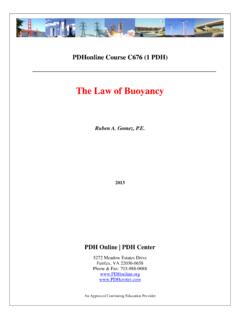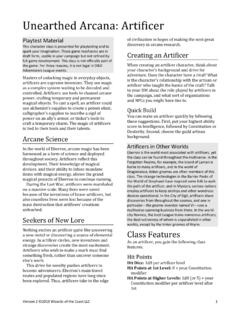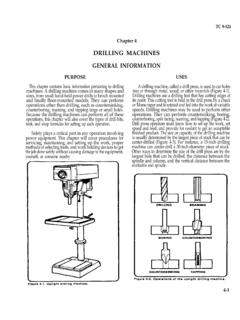Transcription of Design of Bolted and Welded Connection per AISC LRFD 3rd ...
1 PDHonline Course S154 (4 PDH) Design of Fully Restrained MomentConnections per AISC LRFD 3rdEdition (2001)2012 Instructor: Jose-Miguel Albaine, , Online | PDH Center5272 Meadow Estates DriveFairfax, VA 22030-6658 Phone & Fax: Approved Continuing Education PDH Course S154 Page 1 of 28 Design of Fully Restrained Moment Connections AISC LRFD 3rd Edition (2001) COURSE CONTENT 1. TYPES OF CONSTRUCTION In steel framework, beam end connections occur quite often that they influence costs very strongly and have attracted a great deal of attention from Design engineers and researches. This effort has resulted in a great variety of forms that can be executed safely. The study of beam end connections entails the considerations of a range of assumptions made in frame analysis regarding these connections. The new AISC specification provides for three basic types of framing, which relate to the end connections of beams to columns .
2 Section of the LRFD specification defines the following types of construction: Type FR (fully restrained), which is commonly referred as rigid frame (continuous frame), considers that connections have enough stiffness to maintain the angles between the connected members. In other words, a full transfer of moment and little or no relative rotation of members within the joint. This type of Connection was formerly referred to as Type 1 construction in previous editions of the AISC. Type PR (partially restrained) assumes that the connections have insufficient stiffness to maintain the angles between the intersecting members. This type of connections requires that the strength, stiffness and ductility characteristics of the connections be considered in the analysis and Design . This course will not cover this type of Connection , formerly referred to as Type 3 construction in previous editions of the AISC. Part 11 of the LRFD deals with an alternative and a more simplified approach, namely the flexible moment Connection .
3 Simple framing is the other type of construction, where the Connection restraint is ignored (unrestrained, free-ended), and the Connection is designed to resist gravity loads only while allowing relative rotation of the connected members (no moment transfer is taken into account). This type of PDH Course S154 Page 2 of 28connection was formerly referred to as Type 2 construction in previous editions of the AISC. The general behavior of these three types of Connection is illustrated below in Figure ; typical examples of these Connection types are shown on Figures 2, 3, and 4. Figure PDH Course S154 Page 3 of 28 Figure 2 Figure 3 Figure 4 PDH Course S154 Page 4 of 281.
4 AISC LRFD 3rd Edition November 2001 Load and resistance factor Design (LRFD) is based on a consideration of failure conditions rather than working load conditions. Members and its connections are selected by using the criterion that the structure will fail at loads substantially higher than the working loads. Failure means either collapse or extremely large deformations. Load factors are applied to the service loads, and members with their connections are designed with enough strength to resist the factored loads. Furthermore, the theoretical strength of the element is reduced by the application of a resistance factor. The equation format for the LRFD method is stated as: iQi = Rn (Eq. 1) Where: Qi = a load (force or moment) i = a load factor (LRFD section A4 Part 16, Specification) Rn = the nominal resistance, or strength, of the component under consideration = resistance factor (for bolts and welds given in LRFD Chapter J, Part 16) The LRFD manual also provides extensive information and Design tables for the Design considerations of bolts in Part 7, Part 9, 10 and Part 16 Chapter J, section J3.
5 Design considerations for welds are addressed in Part 8, and Part 16, Chapter J, section J2. Other parts of the manual cover connections such as flexible moment connections (Part11), bracing and truss connections (Part 13), column splices (Part 14), hanger connections, bracket plates, and crane-rail connections (Part 15). Our discussion will be limited to the Design of fully restrained (FR) moment connections presented in Part 12 and Part 16, Chapter J. PDH Course S154 Page 5 of 28 3. Basic Behavior of FR Moment Connections Fully restrained (FR) moment connections must have sufficient rigidity to maintain the angles between the intersecting angles as shown on Fig. No. 5. Since it is quite difficult if not impossible to achieve full rigidity in a FR moment Connection , the small amount of flexibility present is usually neglected and the connections are idealized as preventing relative rotation.
6 Figure 5 LRFD specification Section B9 states that end connections in FR construction must be designed to carry the factored forces and moments, allowing for some inelastic but self-limiting deformation of a part of the Connection . In a FR Connection the moment can be resolved into an effective tension-compression couple acting as axial forces at the beam flanges, as shown on Fig. No. 6, while the shear force is considered to be resisted entirely through the web shear Connection . The eccentricity in the shear Connection can be neglected entirely since the angle between the members in a FR moment Connection remains unchanged under loading. Axial forces are normally assumed to be distributed uniformly across the beam flanges, and are added to the couple forces from the applied moment. PDH Course S154 Page 6 of 28 Figure 6 Furthermore, moment connections transmit concentrated forces to column flanges, and these forces must be accounted in the Design to prevent local flange bending (from the tension force), local web yielding, web crippling, and web compression buckling caused by the compression force.
7 Horizontal stiffeners may be required to address these local effects in accordance with LRFD Specification (Part 16), Chapter K, sections , , , and respectively. There are a great variety of arrangements for FR moment connections and we will concentrate on three major designs: a) the flange Tee-Stub Bolted FR moment Connection , b) the flanged-plated FR moment Connection , and c) the directly Welded flanged FR moment connections. Both Bolted and Welded considerations will be covered for these connections. 4. Bolting Considerations for FR Moment Connections PDH Course S154 Page 7 of 28 The LRFD allows bolts in bearing in either standard holes or slotted holes perpendicular to the line of force. The applicable limit states for the bolts are covered under Part 7 of the LRFD. Moment resistance of Bolted FR moment connections depends on tension and shear in the fasteners. One of the most common Bolted FR moment connections is the Flange Tee-Stub Connection shown on Fig.
8 Figure 7 The Design of this Connection involves the transfer of the tensile force T through bolts (in the stem of tee) in single shear, and direct tension through bolts in the flange of the tee. The bolts in tension require consideration of prying action . Prying forces arises when a relatively thin plate deflects outward, thus pressing the unsupported edges against the supporting piece, see Fig. 8. PDH Course S154 Page 8 of 28 Figure 8 LRFD section states that for bolts the applied load shall be the sum of the factored loads and any tension resulting from prying action produced by deformation of the connected parts . Procedure to compute prying forces is covered in Part 9 of the LRFD. For FR moment Bolted connections the most commonly used high strength bolts come in two grades: ASTM A325 and ASTM 490. These bolts can be used in several joint types, such as snug-tightened (bearing joints), pretensioned joints, and slip-critical joints.
9 Each joint type is to be specified in accordance with the required performance in the structural Connection . Although the unfinished bolt designated as ASTM A307 is not precluded to be used in FR moment connections (except for the limitations specified in LRFD ), these bolts are primarily used in light structures, secondary or bracing members, platforms, catwalks, purlins, girts, light trusses, and other structures with small loads and static in nature. The A307 bolts are used predominantly in connections for wood structures. PDH Course S154 Page 9 of 28 Example 1 Design a Bolted T-Stub moment Connection for the beam shown on Figure 9, supporting both gravity and wind loads. Figure 9 Design Parameters: Steel Specification ASTM A992 - Bolts ASTM A325 Loads: Dead Moment, MD = 20 ft-kips Live Moment, ML = 38 ft-kips Wind Moment, Mw = 82 ft-kips Shear to be resisted by web Connection (not in the scope of this course) PDH Course S154 Page 10 of 28 Step1: Determine the factored Design moment: D = M = 28 ft-k + = M = ft-k + + L = M = ft-k !
10 ----- Governs (Note, other combinations may be considered in an actual Design , refer to ASCE 7-02) For a W18 x 50, d = 18 in. Step 2 : Find the maximum Tension force on the flange T = C = M / d = x 12 / 18 = kips Step 3: bolt requirements Try 7/8 diameter bolts Single shear at the beam flanges and tension at the column face a) Tee to beam flanges: From AISC LRFD Table 7-10, the Design shear strength of a 7/8 A325 bolt with the threads included in the shear plane (snugged-tight joint) FV = kips [from FnAb (Table , where = , Fn = 48 ksi, and Ab = in2)] No. of bolts required = / = USE 6 bolts to connect the T-stubs to the beam flanges b) Tee to column: From AISC LRFD Table 7-14, the Design tensile strength of a 7/8 A325 bolt is given as: Ft = kips [from FnAb (Table , where = , Fn = 90 ksi, and Ab = in2)] No. of bolts required = / = USE 4 bolts to connect the T-stubs to the column flange PDH Course S154 Page 11 of 28 Check Prying effect, Figure 10 (from LRFD Part 9): T-Stub Properties: tf = in tw = in bf = in g = 4 in The thickness required to eliminate prying action tmin is determined by: Figure 10 PDH Course S154 Page 12 of 28 Where: rut = / 4 = 29 kips p = tributary length of flange per pair of bolts p = ( + 2 x ) / 2 = <= g then p = 4 in (see Figure No.
